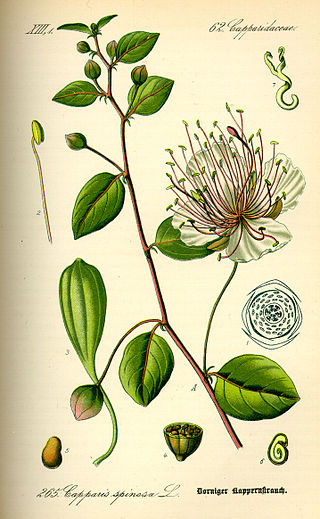
Capparis spinosa, the caper bush, also called Flinders rose, is a perennial plant that bears rounded, fleshy leaves and large white to pinkish-white flowers.

The wild orange is an Australian native plant found in dry inland areas of Australia. Its scientific name is Capparis mitchellii. It is not related to oranges, nor to the Osage-orange which is known as "wild orange" in North America, but to capers.

Colotis evagore, the desert orange tip, small orange tip, or tiny orange tip, is a butterfly of the family Pieridae. It is found in the dry parts of tropical Africa, northern Africa, southern Spain and southwest Arabia.
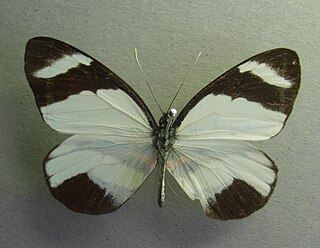
Perrhybris pamela, the Pamela, is a butterfly of the family Pieridae. It is found from Mexico, Honduras, El Salvador, Costa Rica and Panama, south to Colombia, Venezuela, Suriname, French Guiana, Brazil, Ecuador, Peru, and Bolivia. This species breeds in lowland rainforest at altitudes between sea level and about 900 metres.
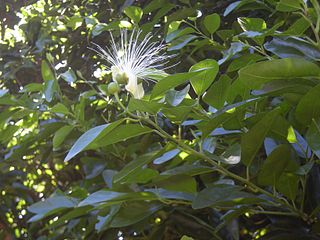
Capparis arborea is a bush or small tree occurring in eastern Australia. Its habitat is rainforest, usually riverine, littoral or the drier rainforests. It is distributed from the Hunter River, New South Wales to Cape Melville in tropical Queensland. Common names include native pomegranate, wild lime, wild lemon and brush caper berry. Capparis arborea is a host plant for the caper white , which migrate across the eastern seaboard in large numbers in the summer. It also feeds the chalky white
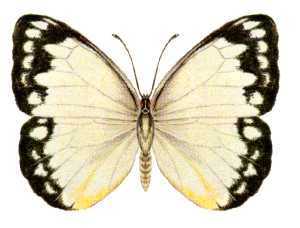
Cepora perimale, the caper gull, is a butterfly in the family Pieridae. It is found on Norfolk Island and in New South Wales, the Northern Territory, Queensland, Victoria, Western Australia, Fiji, Irian Jaya, Maluku, Sulawesi, New Caledonia, Papua New Guinea, the Solomon Islands and Vanuatu.

Colotis evenina, the common orange tip, is a butterfly of the family Pieridae. It is found in the Afrotropical realm.

Pinacopteryx is a monotypic genus of pierid butterflies found in Africa containing Pinacopteryx eriphia, the zebra white.

Dixeia pigea, the ant-heap small white or ant-heap white, is a butterfly in the family Pieridae that is native to Africa.

Belenois zochalia, the forest white or forest caper white, is a butterfly of the family Pieridae. It is found in Africa.

Elodina is a genus of butterflies in the family Pieridae. It is the only genus of the tribe Elodinini. It contains about 30 species.
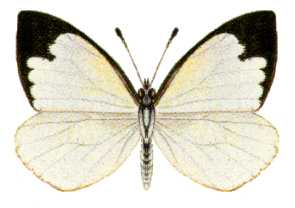
Elodina padusa, the narrow-winged pearl white, is a butterfly in the family Pieridae. It is found across the central latitudes of Australia, including Victoria and South Australia.

Elodina parthia, the chalk white, is a butterfly in the family Pieridae. It is found in the Australian states of New South Wales and Queensland.

Elodina perdita, the northern pearl white or delicate pearl white, is a butterfly in the family Pieridae. It is found in the tropical north of Queensland, Australia.
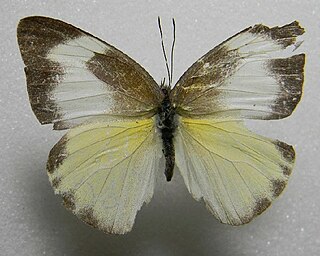
Appias drusilla, the Florida white or tropical white, is a butterfly in the family Pieridae. It is found in tropical America from Brazil north to southern peninsular Florida and the Florida Keys and Antilles. It frequently visits coastal Texas and is a rare stray to Nebraska and Colorado. The habitat consists of tropical lowland evergreen or semideciduous forests.

Pieriballia is a genus of butterflies in the family Pieridae erected by Alexander Barrett Klots in 1933. Its only species, Pieriballia viardi, the painted white or viardi white, was first described by Jean Baptiste Boisduval in 1836. It is found from Mexico to Bolivia and Paraguay. Strays can be found in southern Texas in the United States. The habitat consists of rainforests and transitional cloud forests.

Itaballia demophile, the cross-barred white, crossbarred white, or black-banded white, is a butterfly in the family Pieridae. It is found from the southern United States, and Mexico to Paraguay. The habitat consists of disturbed areas including forest clearings, riverbanks, roadsides, fields, cattle pastures and wasteland.

Itaballia pandosia, the Pisonis mimic or brown-bordered white, is a butterfly in the family Pieridae. It is found in the Amazonian regions of Brazil, Ecuador, Peru, and in Central America, Colombia and Venezuela. The habitat consists of primary rainforests. It may be a mimic of Moschoneura pinthous
Agassiziella angulipennis is a moth in the family Crambidae. It is found in India, where it was described from the Nilgiri district, as well as Sri Lanka. A. angulipennis has a wingspan of 14–17 mm, and was accidentally introduced to the United Kingdom. It has been naturalised to aquatic nurseries there.

Capparis lucida, commonly referred to as the coast caper, is a versatile plant that often grows as a small tree or a shrub, usually reaching heights of 3 to 4 meters. While it may sometimes climb, it typically produces flowers and fruits as a shrub. The leaves are glossy and range from 3 to 10 cm long and 2 to 5 cm wide, with a noticeable central vein and smaller veins forming loops near the edges. Both the petioles and twigs are covered in fine, soft hairs.



















